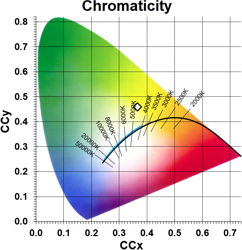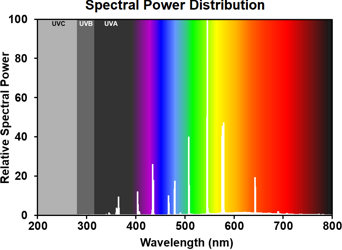
|
Osram MAF/V Mercury Fluorescent |

The luminescent material is zinc cadmium sulphide activated by copper, (Zn,Cd)S:Cu. It is stimulated by the 365nm UV-A that is able to pass through the hard glass inner arc tube, and produces a weak orange radiation which boosts the red ratio of the lamp from 1% to about 4%. Since the phosphor loses its efficiency above about 150°C, MAF lamps employ a large bulb. This has an isothermal shape to maintain a low surface temperature when operated in the cap-up position.
One drawback of this phosphor is its yellow body colour, which absorbs the mercury blue lines. Despite its own orange radiation, the net result is a rather unpleasant greenish light. This was partially overcome by adding cadmium and sometimes also zinc to the arc tube, which radiates extra blue lines plus a small amount of red. This helps achieve a whiter appearance, but the colour still leaves a lot to be desired - the chromaticity diagram below illustrates its high CCy co-ordinate. The addition of cadmium also causes about 12% decrease in lamp efficacy. Due to the fact that Cadmium has a much lower vapour pressure than mercury, the addition of that metal to a normal MA mercury arc tube would have very little effect. To help bring its vapour into the plasma the lower end of the arc tube is tapered, to increase its cold spot temperature and vapourise more of the metal additives.



| Manufacturer: | The General Electric Company of England PLC | |
| Lamp Power: | 400 Watts | |
| Lamp Current: | 3.25 Amps | 5.0A during starting |
| Lamp Voltage: | 130 Volts | For 220-230V Mains |
| Cap Type: | E40s/45 | Brass + porcelain |
| Bulb Type: | BT-165 | BT-56 in eighths/inch |
| Bulb Finish: | Zinc Cadmium Sulphide | (Zn,Cd)S:Cu |
| Electrodes: | C-6 Open Coil | Thoria pellet emitter |
| Arc Length: | 160mm | 6¼ inches |
| Atmosphere: | Inner: HgCd | Ar (1 atm) | Outer: Nitrogen |
| Luminous Flux: | 15,250 lm (@ 100 hrs) | 12,800 lm (average) |
| Luminous Efficacy: | 38.1 lm/W (@ 100 hrs) | 32.0 lm/W (average) |
| Colour Temperature & CRI: | CCT: 4650K | CRI: Ra 29 |
| Chromaticity Co-ordinates: | CCx: 0.365 | CCy: 0.461 |
| Lifetime: | Not published | |
| Warm-up & Re-strike Time: | 5 minutes | 10 minutes |
| Burning Position: | Vertical cap up | |
| Overall Length: | 335 ± 7.5 mm | 13¼ inches |
| Light Centre Length: | 190 ± 8 mm | 7½ inches |
| Factory: | Hammersmith | England |
| Date of Manufacture: | August 1952 | Date Code: 32 |
| Original Value: | £3 12s 6d | (1951) |

